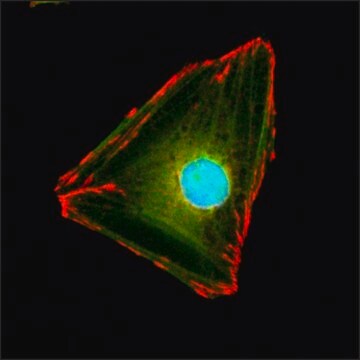05-417
Anti-Paxillin Antibody, clone 5H11
clone 5H11, Upstate®, from mouse
Synonym(s):
FLJ16691, paxillin
About This Item
Recommended Products
biological source
mouse
Quality Level
antibody form
purified immunoglobulin
antibody product type
primary antibodies
clone
5H11, monoclonal
species reactivity
chicken, rat, bovine, mouse, human, avian
manufacturer/tradename
Upstate®
technique(s)
immunocytochemistry: suitable
immunoprecipitation (IP): suitable
western blot: suitable
isotype
IgG1
NCBI accession no.
UniProt accession no.
shipped in
dry ice
target post-translational modification
unmodified
Gene Information
human ... PXN(5829)
rat ... Pxn(360820)
General description
Specificity
Immunogen
Application
4 μg of a previous lot of antibody immunoprecipitated paxillin from 500 μg of a 3T3/A31 RIPA lysate.
Immunocytochemistry:
5-10 μg/mL of a previous lot gave positive immunostaining for paxillin in REF (rat embryo fibroblast) 52 cells fixed with 3.7% paraformaldehyde for 5 minutes.
Signaling
Cytoskeletal Signaling
Quality
Western Blot Analysis:
0.5-2 μg/mL of this lot detected paxillin in RIPA lysates from 3T3/A31 fibroblasts.
Target description
Linkage
Physical form
Storage and Stability
Handling Recommendations:
Upon first thaw, and prior to removing the cap, centrifuge the vial and gently mix the solution. Aliquot into microcentrifuge tubes and store at -20°C. Avoid repeated freeze/thaw cycles, which may damage IgG and affect product performance. Note: Variability in freezer temperatures below -20°C may cause glycerol-containing solutions to become frozen during storage.
Analysis Note
Positive Antigen Control: Catalog #12-305, 3T3/A31 lysate. Add 2.5 μL of 2-mercapto-ethanol/100 μL of lysate and boil for 5 minutes to reduce the preparation. Load 20 μg of reduced lysate per lane for minigels.
Other Notes
Legal Information
Disclaimer
Not finding the right product?
Try our Product Selector Tool.
Storage Class Code
12 - Non Combustible Liquids
WGK
WGK 1
Flash Point(F)
Not applicable
Flash Point(C)
Not applicable
Certificates of Analysis (COA)
Search for Certificates of Analysis (COA) by entering the products Lot/Batch Number. Lot and Batch Numbers can be found on a product’s label following the words ‘Lot’ or ‘Batch’.
Already Own This Product?
Find documentation for the products that you have recently purchased in the Document Library.
Our team of scientists has experience in all areas of research including Life Science, Material Science, Chemical Synthesis, Chromatography, Analytical and many others.
Contact Technical Service








